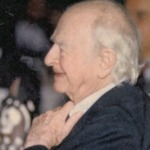Interviewer: Thomas Hager
Interview Date: October 14, 1992
Location: Linus Pauling Institute of Science and Medicine, Palo Alto, California
Duration: 1:35:59
This interview between Linus Pauling and biographer Thomas Hager begins with a discussion of Pauling’s interest in science fiction. Pauling explains that he first started reading science fiction novels when he was a child and that he still subscribes to a few science fiction journals and enjoys their stories. He has ideas for his own novel but has never found the time to write it. From there, the conversation turns to what forms of entertainment he currently enjoys, including the movies and news he watches. Pauling also reminisces on the forms of entertainment he and his wife Ava Helen enjoyed in the past, including seeing the ballet when they were in California and watching musicals when they visited New York.
The interview then moves on to the subject of Pauling’s Nobel Prizes and what he did with the money he earned from those awards. He explains that he used the money from the Chemistry prize to buy his ranch and that some of the money from the Nobel Peace Prize likely financed the Oslo Conference and other peace appeals. Pauling also discusses his financial circumstances throughout his career and his belief that his political activism likely has made a negative impact on his salary.
Pauling and Hager then discuss Pauling’s role in the development of a structure for DNA. Pauling explains that he initially believed that DNA was three-stranded. He details the evidence that led him to his conclusion and discusses how the model published by Watson and Crick led him to abandon that idea. Pauling also talks about his interactions with Watson and Crick and other scientists who studied the structure of DNA, including Jerry Donohue. The interview then concludes with a brief discussion of Pauling’s original falling out with Art Robinson, and their disagreements throughout the years.
Dublin Core
Title
Description
The interview then moves on to the subject of Pauling’s Nobel Prizes and what he did with the money he earned from those awards. He explains that he used the money from the Chemistry prize to buy his ranch and that some of the money from the Nobel Peace Prize likely financed the Oslo Conference and other peace appeals. Pauling also discusses his financial circumstances throughout his career and his belief that his political activism likely has made a negative impact on his salary.
Pauling and Hager then discuss Pauling’s role in the development of a structure for DNA. Pauling explains that he initially believed that DNA was three-stranded. He details the evidence that led him to his conclusion and discusses how the model published by Watson and Crick led him to abandon that idea. Pauling also talks about his interactions with Watson and Crick and other scientists who studied the structure of DNA, including Jerry Donohue. The interview then concludes with a brief discussion of Pauling’s original falling out with Art Robinson, and their disagreements throughout the years.

